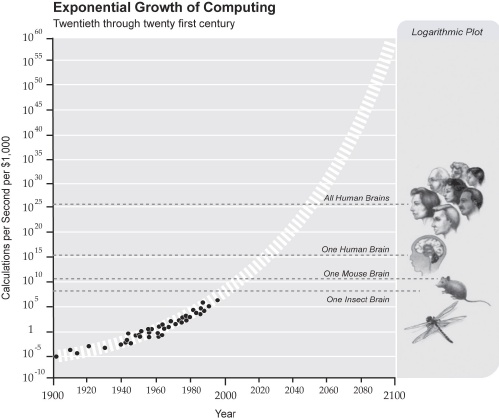The word “singularity” means a time or place in which the normal laws of physics do not apply, such as in a black hole. But there is another singularity with a much different meaning, one which many people say will be coming within the next ten years: The Technological Singularity.
Everybody puts a different date and meaning to the Technological Singularity. Some say it will be when robots take over the world, others say it will be when humans all die or leave earth and leave only super intelligent robots behind. All these involve one similar thing though: A time will come in which robots are smarter than humans. This is a scary thought, and one many people would like to shrug off as science fiction. But how far off is it really? This graph shows calculations per second (also per 1,000 dollars….whatever than means) on the y-axis and year on the x-axis. The white curve represents how technology will advance if it continues at its current rate. The figures on the right show where mice, insects, and humans stand as far as calculations per second go. Finally, the little black dots on the line show dates where the computers with the number of calculations per second were created, and they are the reference points for drawing the white curve.
The graph is fairly old, with the newest point being from 1998, so this graph seems like sort of a stretch right? Wrong. Last year Tianhe-1 was put into action in China as the second computer able to process a quadrillion processes per second. That’s equal to 1015, or just short of a human’s brain. So technology is actually advancing faster than the graph suggests!
All that being said computers are still ultimately limited. Unless built into a robot, computers are unable to build or use anything outside of cyberspace. So instead we must relate to robots, what if such an advanced computer was made into a walking robot? What would it be capable of? Some people say nothing at all outside of its programming. Robots/Computers are incapable of emotions. But is it possible to create a robot capable of emotions? In 2007, three US scientists successfully simulated half of a mouse brain, resulting in activity characteristic of thought patterns with similar nerve synapse firing as observed in mice in nature. The complex simulation only was able to last ten seconds, however this is just the beginning. If scientists can successfully create a real working mouse brain, how far are they really from a human-like one? Another interesting robot-rat combo: http://www.youtube.com/watch?v=1-0eZytv6Qk
So if robots are capable of thinking and acting like humans, what will happen then? Well, either we would coexist, or robots would take over in the work force. Robots don’t have to take breaks, eat, or drink. So what will humans do? Probably all die off.
So do I believe it? Yes I do. I think there will come a time when robots are as intelligent as humans. But I think that as long as we keep a nice “STOP ALL” switch around, we’ll be just fine.
References:

Well...I see it as the computers are only as smart as the people who design/program them. They are certainly faster at processing/calculating data because there are no emotions/thoughts that get in the way of the process. IF emotions were ever programmed into robots, the emotions would not vary. They would only be as a result of a variance in something such as temperature. The response would not be because of the way it feels (sad, hurt, happy, etc.). So, I guess it may be possible in the future, but I can never envision anything having all of the abilities of a human. But, it may be better and faster at some things.
ReplyDelete